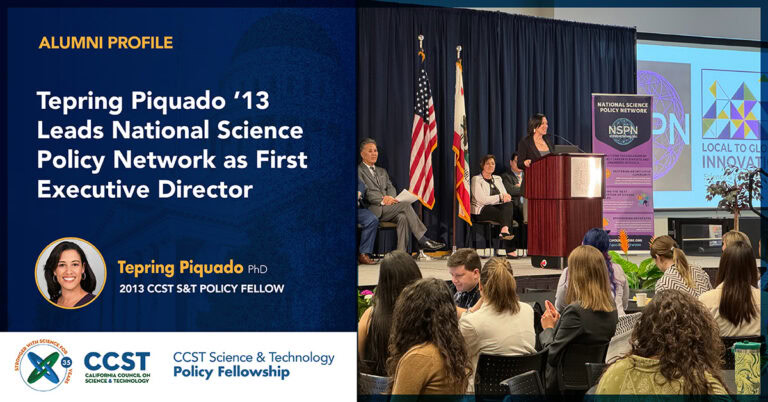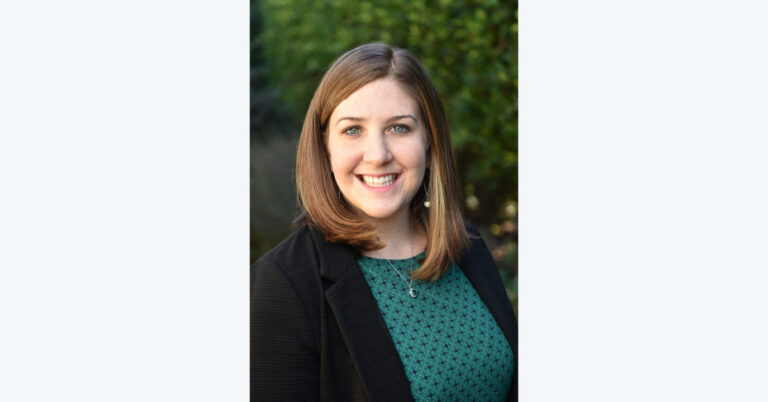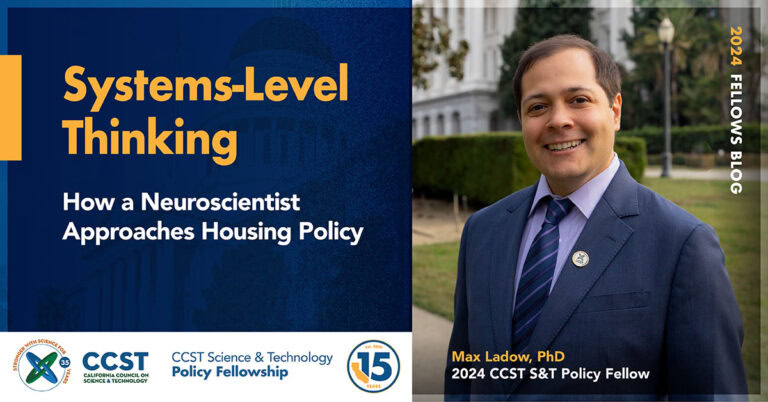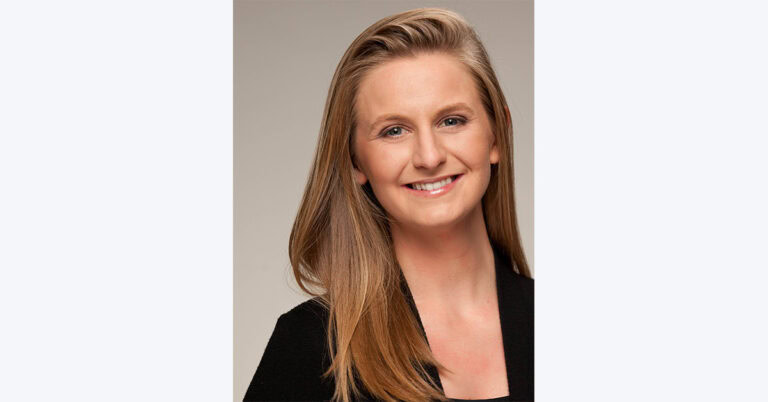Alumni Profile: Tepring Piquado ’13 Leads National Science Policy Network as First Executive Director
From Biostatistics to Pesticide Policy: Q&A with Natalie Gasca
September 14, 2022 | CCST Newsroom, CCST S&T Policy Fellows
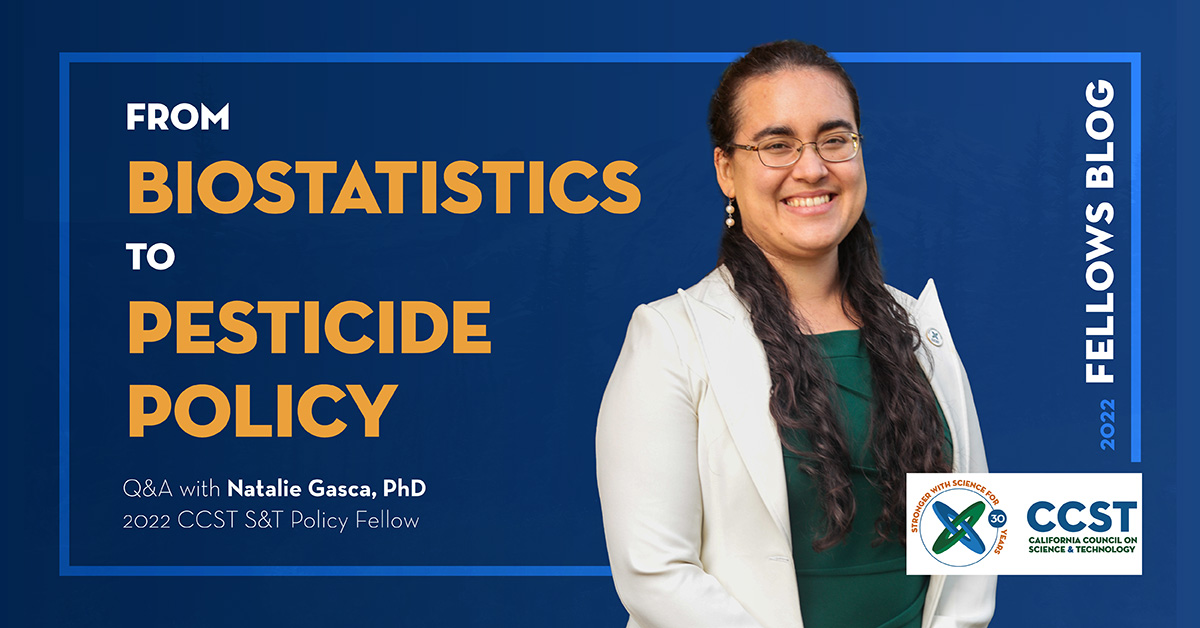
What did you study in grad school and why did you decide to go into policy?
As part of my biostatistics PhD program at the University of Washington, I investigated ways to use nutritional information from the Multi-Ethnic Study of Atherosclerosis—designed to research predictors of cardiovascular disease—to identify heart-healthy diet patterns. I considered ways to summarize the complicated diet data in a reasonable fashion, and how to interpret and visualize patterns in the data that associated with a participant’s first heart disease event.
During this time, I built partnerships with clinical collaborators and local nonprofits, attended interdisciplinary conferences, and contributed to science communication initiatives in Spanish—including an effort to clarify COVID-19 guidance for people in Mexico through a cross-institutional Mexicans in Statistics and Health group. These experiences have highlighted for me how much can be gained by combining different types of expertise and they have translated well to my work in policy.
As important as research is, its successful translation into public messaging and policy is vital to tangibly improving the health and wellbeing of others.

Where are you placed for the Fellowship and what issue area(s) do you work on?
The CCST S&T Policy Fellows program positions PhD scientists and engineers in either the State Legislature or Executive Branch to experience and contribute to public policy and see if this is a setting where we want to continue sharing our skills. To do this, the program trained us for the first month and a half about how laws and decisions get made in California, which was my first practical introduction to how the state government works.
After training, I was placed with the California Department of Pesticide Regulation (DPR), which aims to protect human health and the environment by regulating pesticide sales and use, and by fostering reduced-risk pest management. It’s been fascinating to see the different sets of expertise and approaches between DPR teams, DPR executive leaders, external partners, stakeholders, and others.
As important as research is, its successful translation into public messaging and policy is vital to tangibly improving the health and wellbeing of others.
I’ve really appreciated the chance to learn the way that government culture operates and how it differs from academia. In this setting, I’ve been able to highlight a wider breadth of my skillset including interpersonal, organizational, and writing skills—and there is certainly a lot of writing involved in policy work (for me in both English and Spanish). I’m grateful that my input and suggestions have been considered so early on at DPR, and so thankful to the mentors who have helped me transition with their advice—even on little things like who to include in an email.

How familiar were you with pesticides and how has your PhD training informed your experience so far?
Pesticides are a lot broader of a category than I expected! Apart from those that are used in the more typical agricultural setting, pesticides can also be things like hand sanitizers, algicide pool cleaners, bleach products, and termite tents.
Though I hadn’t studied pesticides in much detail before, I have been able to use my technical training to quickly review reports, assess study protocols, and listen to scientific presentations. I’m not deep diving into the science behind the pesticides—DPR already has many talented chemists and biologists for that—but I am contributing through science communication, especially for some of the more public-facing projects this year.
For most of my projects, I have relied heavily on my project management experience that I gained by conducting my dissertation project, as well as my various communication, leadership, and networking experiences that I have undertaken since my undergraduate years. Lastly, my community service and civic engagement experiences lend a beneficial context for my public outreach role and interactions with various stakeholders.

Where were you before the Fellowship and how was your experience there?
After growing up in Southern California and earning my bachelor’s degree, I moved to Seattle to pursue my PhD at the University of Washington. I really enjoyed the variety of local restaurants (especially Asian food) and vibrant coffee shops I was able to try. In the spring, I appreciated attending Seattle International Film Festival events and visiting with local family members. The long summer days were really nice, especially when getting to see the gorgeous Olympic, Cascades, and Rainier mountain views. I even got to experience some “heavier” snow falls, for the first time. I’m grateful to have pursued my graduate degree in an environment rich with nature and with an extensive public transit system.

How are you adjusting to the remote work aspect of your position?
As I finished the last year and a half of my PhD program during the pandemic, I already had some experience with how to work remotely in an effective and practical way and take breaks to keep the momentum going (like my lunchtime Seattle-based Zumba classes, when time allows). Also, as I live in the East Bay, I am grateful that my “mostly remote” schedule means that I spend much less time commuting.
On the other hand, when I was 5 months in I had met less than 5 people in person at DPR, even though I’d interacted with over 50 staff members in virtual meetings. However, after a department picnic celebration, I had the chance to chat with many coworkers (heights are a thing outside of Zoom!). Compared to some of the other Fellows in the Legislature, I did find it a bit more challenging to meet folks outside of the department at first, though my more recent projects have presented many opportunities to interact with other government and stakeholder partners.
Throughout the experience, it’s been really nice to have the support and comradery of other current fellows, alumni, and DPR coworkers, especially when we do have chances to meet in person. I also appreciate getting to connect with a variety of DPR’s partners and stakeholders through virtual meetings, which would be harder to coordinate in-person.

How did your personal and academic interests shape your thoughts about career opportunities to pursue?
I aspire to use my analytical and communication skills to address health priorities for underserved communities.
During my statistical training, I enjoyed sharing interdisciplinary findings, empowering students, and collaborating with physicians, health researchers, and nonprofits. Through this fellowship, I have been able to engage at the intersection of communication, science, and public policy, and appreciate how other professionals have combined these across a breadth of careers.
These reflections remind me of some of the takeaways from a solo travel fellowship I participated in four years ago. While traveling across Polynesia, Asia, and Latin America, I met people with vastly different upbringings who were invested in helping others at whatever level they could, often relying on creativity and compassion. That gave me even more motivation to continue my goal of helping as many people as I can with my career.
This experience also reinforced who I am as a person, someone who is much more extroverted, social, and connected to people. It was satisfying to recognize this trait as a crucial asset on this type of adventure and now in public policy—being friendly enough to open up to people, ask questions, and genuinely be interested in their lives. Making these types of connections is key when working with so many organizations and teams. I hope to continue to inform public policy through communication and relationship-building, while also using my technical training to evaluate program effectiveness. My prior experiences combined with my CCST fellowship experience at DPR have made me more open to the breadth of careers available with the set of experiences I now have.

What are your career goals and how is the Fellowship impacting them?
My interest in patterns and statistics led me to be a math major, but I was also driven to help people, so I contributed my time to many community service projects as an undergrad. While I valued the one-on-one connections I made with people, I thought that I could make a bigger impact if I approached problems on a broader scale, such as through public health. I attended several conferences such as the Society for Advancement of Chicanos/Hispanics and Native Americans in Science (SACNAS) which helped me to see biostatistics as the bridge between these two interests. At these conferences, I met many people from industry, government and academia and got see the breadth of career choices available.
My goal for attaining my PhD was to be better equipped to serve community groups by sharing my technical training to help quantify the impact of community-based interventions and enable them to gain more resources. After getting my PhD, the CCST fellowship has enabled me to better understand the range of considerations that go into creating and implementing public policy—affecting all aspects of Californians’ lives.
Learn More: Discover how our CCST S&T Policy Fellows make a difference in California’s policy arena and learn how to apply on our Fellows page.
More specifically, I’ve been able to hear from a variety of groups that value integrating scientific research with political advocacy. I’ve connected with speakers from our fellowship’s Friday seminars, CCST alumni and mentors, DPR and CalEPA staff, and a wide array of partners and stakeholders. I hope to leverage these relationships to continue my work in State government or find a collaborative organization where I can continue contributing to improving the lives of Californians, particularly those from underserved communities.

About the CCST Science & Technology Policy Fellowship
The CCST Science & Technology Policy Fellows program trains scientific thinkers to be policy-savvy, while helping equip California’s decision makers with science-savvy staff. The program was established in 2009 with funds from the Gordon and Betty Moore Foundation and other generous friends. Discover how our CCST S&T Policy Fellows make a difference in California’s policy arena and learn how to apply at ccst.us/ccst-science-fellows-program.

